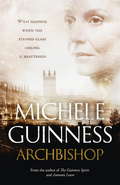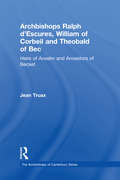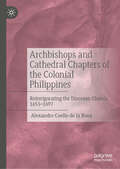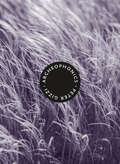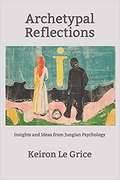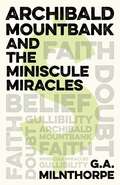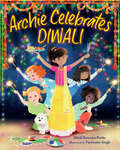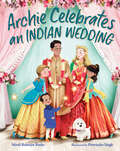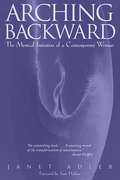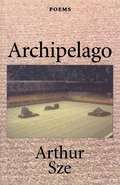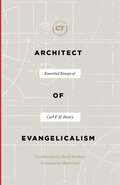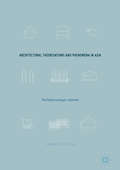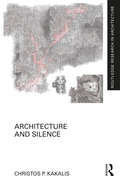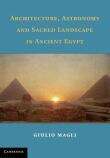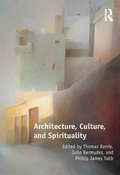- Table View
- List View
Archbishop: A Novel
by Michele GuinnessFive years from now, the Church of England is on its knees. Yet one woman is making a difference, and when she is appointed Archbishop of Canterbury, anything could happen.Vicky Burnham-Woods is a master of diplomacy, and deeply committed to bringing the church back into the heart of community and cultural life - but not everyone wants a woman at the top, and behind the scenes dark forces are moving.Can the first ever female Archbishop of Canterbury last long enough to achieve her mission?
Archbishop: A novel
by Michele GuinnessFive years from now, the Church of England is on its knees. Yet one woman is making a difference, and when she is appointed Archbishop of Canterbury, anything could happen.Vicky Burnham-Woods is a master of diplomacy, and deeply committed to bringing the church back into the heart of community and cultural life - but not everyone wants a woman at the top, and behind the scenes dark forces are moving.Can the first ever female Archbishop of Canterbury last long enough to achieve her mission?
Archbishops Ralph d'Escures, William of Corbeil and Theobald of Bec: Heirs of Anselm and Ancestors of Becket (The Archbishops of Canterbury Series)
by Jean TruaxThe first two archbishops of Canterbury after the Norman Conquest, Lanfranc and Anselm, were towering figures in the medieval church and the sixth archbishop, the martyred Thomas Becket, is perhaps the most famous figure ever to hold the office. In between these giants of the ecclesiastical world came three less noteworthy men: Ralph d'Escures, William of Corbeil, and Theobald of Bec. Jean Truax's volume in the Ashgate Archbishops of Canterbury Series uniquely examines the pontificates of these three minor archbishops. Presenting their biographies, careers, thought and works as a unified period, Truax highlights crucial developments in the English church during the period of the pontificates of these three archbishops, from the death of Anselm to Becket. The resurgent power of the papacy, a changed relationship between church and state and the expansion of archiepiscopal scope and power ensured that in 1162 Becket faced a very different world from the one that Anselm had left in 1109. Selected correspondence, newly translated chronicle accounts and the text and a discussion of the Canterbury forgeries complete the volume.
Archbishops and Cathedral Chapters of the Colonial Philippines: Reinvigorating the Diocesan Church, 1653-1697
by Alexandre Coello de la RosaThis volume analyzes the religious history of the early modern Philippines. It examines the unstable authority of its archbishops and the preeminence of the Manila cathedral chapters in the second half of the seventeenth century. In particular, it considers these phenomena during the various convoluted periods of vacant sees, paying special attention to the dynamics of promotions within these collegiate bodies.
Archeophonics (Wesleyan Poetry Ser.)
by Peter GizziSoulful and intricate lyrics make this Gizzi's strongest book to dateArcheophonics is the first collection of new work from the poet Peter Gizzi in five years. Archeophonics, defined as the archeology of lost sound, is one way of understanding the role and the task of poetry: to recover the buried sounds and shapes of languages in the tradition of the art, and the multitude of private connections that lie undisclosed in one's emotional memory. The book takes seriously the opening epigraph by the late great James Schuyler: "poetry, like music, is not just song." It recognizes that the poem is not a decorative art object but a means of organizing the world, in the words of anthropologist Clifford Geertz, "into transient examples of shaped behavior." Archeophonics is a series of discrete poems that are linked by repeated phrases and words, and its themes and nothing less than joy, outrage, loss, transhistorical thought, and day-to-day life. It is a private book of public and civic concerns.
Archetypal Reflections: Insights And Ideas From Jungian Psychology
by Keiron Le GriceIn this book, Keiron Le Grice shares his expertise in depth psychology and its central preoccupation: the workings of the unconscious mind. Adapted from his teaching in the Jungian and Archetypal Studies specialization at Pacifica Graduate Institute, California, Archetypal Reflections provides concise paragraph-length analyses and explanations of a wide range of topics, focusing on the work of C. G. Jung and other influential figures such as Nietzsche, Freud, Campbell, and Hillman. Skillfully illuminating Jung's theories of archetypes, individuation, the Self, and synchronicity, Le Grice also explores a number of other fascinating topics such as the role of the unconscious and myth in modern culture, the evolution of consciousness and civilization, the quest for spiritual meaning in a secular age, and the intersection of depth psychology and the new sciences. The primary concern throughout is the capacity of depth psychology to inform and transform our worldview, addressing the question of how we might find greater meaning and spiritual fulfillment in life. Le Grice shows how Jungian ideas can provide a source of deep wisdom to inform the inner journey and help us to better understand our place in the larger scheme of things.
Archibald Mountbank and the Miniscule Miracles
by G. A. MilnthorpeArchibald Mountbank has the power to make almost anything 1% better. Whether you want to be 1% better looking or 1% taller, Archibald Mountbank is your man. He can even boost your immune system or your willpower... for a fee. Archibald Mountbank, one of the richest (and most hated) men in Britain, is about to retire from his highly contentious "profession". But before he retires, Mountbank's Commercial Manager has accepted an offer to allow Mountbank to be shadowed by a journalist. Alistair Dodd, a cynical journalist commissioned to write a hatchet job biography, gets a rare look into the life and practices of the elusive Mountbank and discovers that everyone needs to believe in something... it's just a question of what.
Archie Celebrates Diwali
by Mitali Banerjee RuthsIt's Archie's favorite holiday—Diwali. And this year she gets to share it with her friends and introduce them to the festival of lights!Archana loves her family's annual Diwali (deh-vah-lee) party, and this year she gets to share it with all her friends from school. She helps with the decorations and the food, and is eager for everyone to arrive. But once the party starts a thunderstorm kicks up and drenches the outside decorations and knocks out the power. Archie worries that everything will be ruined. How can there be a festival of lights without any electricity?
Archie Celebrates an Indian Wedding
by Mitali Banerjee RuthsKindhearted Archie is back! Her Poppy Uncle is getting married in a big Indian wedding, and Archie and new friend Emma realize that love and fun are universal.In this cross-cultural friendship story, Archie helps Emma, who isn&’t Indian, learn everything she needs to know when Archie&’s Poppy Uncle and Emma&’s Auntie Julie get married. The girls go to the mehendi party and sangeet together. They help Julie at the wedding, steal Poppy&’s shoes, and eat ladoos at the reception. Now Archie and Emma are friends—and cousins!Archie&’s adventures celebrate Indian culture! We first met Archie in Archie Celebrates Diwali and now join her in the follow-up Archie Celebrates an Indian Wedding. Backmatter in Archie's books feature kid-friendly resources to enrich the reading experience.
Arching Backward: The Mystical Initiation of a Contemporary Woman
by Janet AdlerArching Backward is the story of an American woman who found herself suddenly and violently immersed in a mystical initiation for which she was not consciously prepared. For four years, Janet Adler's life was dominated by the transforming experience of a primal energy and the visions that were created by it. She was not seeking spiritual experience, nor was she a student of any particular mystical tradition. But the visions brought her into the realm of the sacred, transforming her body into a conduit for spiritual energy. The writings collected here record her visions and describe the way this contemporary woman dealt with the impact of this energy on her physical body, her work, and her relationships. Her story offers a guide for others on this journey and provides a powerful affirmation of women's experience of the spirit.
Archipelago
by Arthur SzeArthur Sze has captured what it means to be a Chinese-American through a book of poems. Sze's poetry moves beyond issues and questions of culture and into the natural world.
Architect of Evangelicalism: Essential Essays of Carl F. H. Henry (Best of Christianity Today)
by Carl F. H. HenryDiscover the ongoing relevance of the essential evangelical. In recent years, the label "evangelical" has been distorted and its usefulness questioned. No one is better equipped to provide a clear understanding of evangelicalism than the late Carl F. H. Henry, the founding editor of Christianity Today and the most influential theologian of American evangelicalism in the twentieth century. While Billy Graham was preaching the gospel to stadiums full of people, Henry was working tirelessly to help Christians adopt a worldview that encompasses all of life. Architect of Evangelicalism helps us gain a better sense of the roots of American evangelicalism by giving us the best of Henry's Christianity Today essays on subjects such as what defines evangelicalism, what separates it from theological liberalism, what evangelical Christian education should look like, and how evangelicals should engage with society.
Architectural Theorisations and Phenomena in Asia: The Polychronotypic Jetztzeit
by Francis Chia-Hui LinThis book is the first overall and detailed discussion of contemporary Asia's architectural theorisations and phenomena based on its heteroglossic and decolonisation character. Lin presents a theoretical journey of transdisciplinary reflection upon contemporary Asia's pragmatic phenomena which is methodologically achieved by means of elaborations of how tangible Asian architecture can be philosophically theorised and how interchangeable architectural theory is practically 'Asianised'. Discussions in the book are critically integrated with comparative studies focused on Japan, Taiwan, China, Hong Kong, Singapore, Malaysia, Australia, New Zealand and the UK. These empirical examinations are highlights of phenomenal localities, architecture, cities and cultures which reference the historicity of the Asia Pacific, Asia's contemporary architectural situations, and their subtle relationship with the 'West'. The schematisation of intended 'fuzziness' for Asia and its architecture is framed as the notion polychronotypic jetztzeit to represent a present time-place context of contemporary Asian architecture and urbanism. This book will be of great interest to scholars of Asian Studies, Architectural Studies, Postcolonial Studies, Urban Studies and Cultural Studies.
Architecture and Ritual in the Churches of Constantinople
by Vasileios MarinisThis book examines the interchange of architecture and ritual in the Middle and Late Byzantine churches of Constantinople (ninth to fifteenth centuries). It employs archaeological and archival data, hagiographic and historical sources, liturgical texts and commentaries, and monastic typika and testaments to integrate the architecture of the medieval churches of Constantinople with liturgical and extra-liturgical practices and their continuously evolving social and cultural context. The book argues against the approach that has dominated Byzantine studies: that of functional determinism, the view that architectural form always follows liturgical function. Instead, proceeding chapter by chapter through the spaces of the Byzantine church, it investigates how architecture responded to the exigencies of the rituals, and how church spaces eventually acquired new uses. The church building is described in the context of the culture and people whose needs it was continually adapted to serve. Rather than viewing churches as frozen in time (usually the time when the last brick was laid), this study argues that they were social constructs and so were never finished, but continually evolving.
Architecture and Sacrament: A Critical Theory
by David WangDavid Wang’s Architecture and Sacrament considers architectural theory from a Christian theological perspective, specifically, the analogy of being (analogia entis). The book tracks social and cultural reasons why the theological literature tends to be separate from contemporary architecture theory. Wang argues that retrieval of the sacramental outlook embedded within the analogy of being, which informed centuries of art and architecture in the West, can shed light on current architectural issues such as "big box stores," the environmental crisis and the loss of sense of community. The book critiques the materialist basis of current architectural discourse, subsumed largely under the banner of critical theory. This volume on how European ideas inform architectural theory complements Wang’s previous book, A Philosophy of Chinese Architecture: Past, Present, Future, and will appeal to architecture students and academics, as well as those grappling with the philosophical moorings of all built environments.
Architecture and Silence (Routledge Research in Architecture)
by Christos P. KakalisThis book explores the role of silence in how we design, present and experi-ence architecture. Grounded in phenomenological theory, the book builds on historical, theoretical and practical approaches to examine silence as a methodological tool of architectural research and unravel the experiential qualities of the design process. Distinct from an entirely soundless experience, silence is proposed as a material condition organically incorporated into the built and natural landscape. Kakalis argues that, either human or atmospheric, silence is a condition of waiting for a sound to be born or a new spatio-temporal event to emerge. In silence, therefore, we are attentive and attuned to the atmos-phere of a place. The book unpacks a series of stories of silence in religious topographies, urban landscapes, film and theatre productions and architec-tural education with contributed chapters and interviews with Jeff Malpas and Alberto Pérez-Gómez. Aimed at postgraduate students, scholars and researchers in architectural theory, it shows how performative and atmospheric qualities of silence can build a new understanding of architectural experience.
Architecture of Devotion: James Goold and His Legacies in Colonial Melbourne
by Jaynie Anderson Max Vodola Shane CarmodyThe Architecture of Devotion: James Goold and His Legacies in Colonial Melbourne honours the life and cultural contribution of Archbishop James Alipius Goold (1812-1886). Goold arrived in 1848 as the first Catholic bishop of the newly created diocese of Melbourne and quickly adapted to Australian colonial conditions, setting about establishing an extraordinary network of schools, churches and welfare institutions across Victoria. Beyond the immediate task of building bluestone, bricks and mortar, Goold carried a grand vision, sensing that Melbourne was on its way to becoming a grand international metropolis. A collector and man of refined taste, Goold not only adorned religious institutions with quality Baroque artwork, but he also amassed a unique book collection and private library that showcased his European cultural sensibilities. A companion to The Invention of Melbourne: A Baroque Archbishop and a Gothic Architect (2019), The Architecture of Devotion brings Goold to life as we follow him around the colony and witness how he shaped the fabric of Victorian suburbs and towns. These volumes have been supported by the Australian Research Council, which has recognised them as among the best research projects in Australia.The Invention of Melbourne was commended in the Victorian Community History Award 'History Publication Award', 2020.
Architecture of the Sacred
by Bonna D. Wescoat Robert G. OusterhoutIn this book, a distinguished team of authors explores the way space, place, architecture and ritual interact to construct sacred experience in the historical cultures of the eastern Mediterranean. Essays address fundamental issues and features that enable buildings to perform as spiritually transformative spaces in ancient Greek, Roman, Jewish, early Christian and Byzantine civilizations. Collectively they demonstrate the multiple ways in which works of architecture and their settings were active agents in the ritual process. Architecture did not merely host events; rather, it magnified and elevated them, interacting with rituals facilitating the construction of ceremony. This book examines comparatively the ways in which ideas and situations generated by the interaction of place, built environment, ritual action and memory contributed to the cultural formulation of the sacred experience in different religious faiths.
Architecture, Astronomy and Sacred Landscape in Ancient Egypt
by Giulio MagliThis book examines the interplay between astronomy and dynastic power in the course of ancient Egyptian history, focusing on the fundamental role of astronomy in the creation of the pyramids and the monumental temple and burial complexes. Bringing to bear the analytical tools of archaeoastronomy, a set of techniques and methods that enable modern scholars to better understand the thought, religion, and science of early civilizations, Giulio Magli provides in-depth analyses of the pyramid complexes at Giza, Abusir, Saqqara, and Dahshur, as well as of the Early Dynastic necropolis at Abydos and the magnificent new Kingdom Theban temples. Using a variety of data retrieved from study of the sky and measurements of the buildings, he reconstructs the visual, symbolic, and spiritual world of the ancient Egyptians and thereby establishes an intimate relationship among celestial cycles, topography, and architecture. He also shows how they were deployed in the ideology of the pharaoh's power in the course of Egyptian history.
Architecture, Culture, and Spirituality
by Thomas Barrie Julio BermudezArchitecture has long been understood as a cultural discipline able to articulate the human condition and lift the human spirit, yet the spirituality of architecture is rarely directly addressed in academic scholarship. The seventeen chapters provide a diverse range of perspectives, grouped according to topical themes: Being in the World; Sacred, Secular, and the Contemporary Condition; Symbolic Engagements; Sacred Landscapes; and Spirituality and the Designed Environment. Even though the authors’ approach the subject from a range of disciplines and theoretical positions, all share interests in the need to rediscover, redefine, or reclaim the sacred in everyday experience, scholarly analysis, and design.
Architecture, Islam, and Identity in West Africa: Lessons from Larabanga
by Michelle ApotsosArchitecture, Islam, and Identity in West Africa shows you the relationship between architecture and Islamic identity in West Africa. The book looks broadly across Muslim West Africa and takes an in-depth study of the village of Larabanga, a small Muslim community in Northern Ghana, to help you see how the built environment encodes cultural history through form, material, and space, creating an architectural narrative that outlines the contours of this distinctive Muslim identity. Apotsos explores how modern technology, heritage, and tourism have increasingly affected the contemporary architectural character of this community, revealing the village’s current state of social, cultural, and spiritual flux. More than 60 black and white images illustrate how architectural components within this setting express the distinctive narratives, value systems, and realities that make up the unique composition of this Afro-Islamic community.
Architektur, Atmosphäre, Wahrnehmung: Die römische Villa als Chance für das Bauen heute
by Christian Illies Andreas Grüner Martin Düchs Sabine Vogt„Nach Rom Architekturstudenten zu schicken heißt, sie für ihr ganzes Leben zu ruinieren.“ (Le Corbusier 1922). Im Sinne dieses Verdikts hat sich die Architekturmoderne radikal von der klassizistischen Tradition abgewandt, in der die antike Baukunst als Schulung, Folie und Muster galt, indem man ihre Formen, Strukturen und Proportionen formalästhetisch analysierte und nachahmte. Doch gab es bereits in der Antike ein anderes Konzept von Architekturverständnis: das sinnliche Erleben von Raumsequenzen und die Gestaltung von Atmosphären. Vorgeführt wird uns ein solches Verständnis in Bauten wie der Villa Hadriana aber auch in den „Villenbriefen“ des römischen Senators Plinius d. J. (um 100 n. Chr.). Von Architekten wurden Letztere lebhaft diskutiert, bis die Moderne jede Beschäftigung mit der Antike „untersagte“.Der Band „Architektur, Atmosphäre, Wahrnehmung“ versammelt nun zehn Beiträge, die wieder alle –mehr oder weniger intensiv – als Ausgangsbasis die Villenbriefe nutzen, allerdings nicht, um mit ihnen einen formalästhetischen Zugriff auf die Antike wiederzubeleben, sondern, weil der von Plinius vorgeführte und in der Forschung bis dato vernachlässigte Blick auf die römische Villa unter dem Aspekt einer sequentiellen Sinnlichkeit eine „Chance für das Bauen heute“ ist.Im Ergebnis kann man festhalten: Egal ob man Architekturstudenten nach Rom schickt oder nicht – in jedem Fall sollte man sie Plinius lesen lassen.
Architektur, Atmosphäre, Wahrnehmung: Die römische Villa als Chance für das Bauen heute (Interdisziplinäre Architektur-Wissenschaft: Praxis – Theorie – Methodologie – Forschung)
by Christian Illies Andreas Grüner Martin Düchs Sabine Vogt„Nach Rom Architekturstudenten zu schicken heißt, sie für ihr ganzes Leben zu ruinieren.“ (Le Corbusier 1922). Im Sinne dieses Verdikts hat sich die Architekturmoderne radikal von der klassizistischen Tradition abgewandt, in der die antike Baukunst als Schulung, Folie und Muster galt, indem man ihre Formen, Strukturen und Proportionen formalästhetisch analysierte und nachahmte. Doch gab es bereits in der Antike ein anderes Konzept von Architekturverständnis: das sinnliche Erleben von Raumsequenzen und die Gestaltung von Atmosphären. Vorgeführt wird uns ein solches Verständnis in Bauten wie der Villa Hadriana aber auch in den „Villenbriefen“ des römischen Senators Plinius d. J. (um 100 n. Chr.). Von Architekten wurden Letztere lebhaft diskutiert, bis die Moderne jede Beschäftigung mit der Antike „untersagte“.Der Band „Architektur, Atmosphäre, Wahrnehmung“ versammelt nun zehn Beiträge, die wieder alle –mehr oder weniger intensiv – als Ausgangsbasis die Villenbriefe nutzen, allerdings nicht, um mit ihnen einen formalästhetischen Zugriff auf die Antike wiederzubeleben, sondern, weil der von Plinius vorgeführte und in der Forschung bis dato vernachlässigte Blick auf die römische Villa unter dem Aspekt einer sequentiellen Sinnlichkeit eine „Chance für das Bauen heute“ ist.Im Ergebnis kann man festhalten: Egal ob man Architekturstudenten nach Rom schickt oder nicht – in jedem Fall sollte man sie Plinius lesen lassen.
Architekturen und Artefakte: Zur Materialität des Religiösen (Veröffentlichungen der Sektion Religionssoziologie der Deutschen Gesellschaft für Soziologie)
by Thomas Schmidt-Lux Uta KarsteinIn der Soziologie ist seit längerer Zeit ein zunehmendes Interesse an Architektur und Artefakten beobachtbar. Dabei wird daran erinnert, dass nicht nur immaterielle Zeichen, Symbole und Repräsentationen des Sozialen existieren, sondern auch Orte, Stoffe und Dinge. Diesen wird eine wichtige Rolle im sozialen Geschehen zugesprochen: Materiales erscheint als Träger von Erinnerungskulturen, als sozialer Akteur, Heilsvermittler, Medium von Repräsentation - kurz: als Bedingung, Beschränkung und Instrument sozialer Praxis. Dies gilt auch in Bezug auf Religion. Dennoch hat die Perspektive noch kaum Eingang in die deutschsprachige Religionssoziologie gefunden. Dieser Band soll daher Anstoß sein für die Öffnung der Religionssoziologie in Richtung einer Soziologie des Materialen.
Architettura dell'Aldilà: Il Codice del Flipside
by Richard MartiniDopo aver filmato 50 casi di persone sotto ipnosi che dicono le medesime cose sull’aldilà (“Flipside”, “L’Aldilà è Meraviglioso” e “Hackerare l’Aldilà”), e aver lavorato con la medium Jennifer Shaffer parlando direttamente con le persone (“Lasciapassare per il Flipside: Conversazioni con l’Aldilà con Jennifer Shaffer”), ho cominciato a concentrare la mia ricerca su persone NON sotto ipnosi, ma che riescono a ricordare un episodio in maniera vivida; un sogno, un’esperienza di pre-morte o qualcosa avvenuto durante uno stato alterato di coscienza. Ponendo semplici domande sulla loro esperienza, ho scoperto che posso “chiedere loro” di invitare le “persone nel Flipside” a unirsi alla conversazione, compresi i loro cari non più sul pianeta, le guide, i maestri e i membri del consiglio che sono a conoscenza di tutte le nostre vite, oltre che ottenere risposte alle domande chiave sulla natura della realtà, sulla coscienza, su come le cose funzionano. Facendo a quasi 50 persone, non soggette ad alcuna forma di ipnosi, “le medesime domande” rivolte a queste “persone nel Flipside”, sono rimasto sorpreso nel constatare che dicono le stesse cose, a proposito del viaggio, dette dalle persone sotto ipnosi. In queste pagine, le persone leggeranno o sentiranno cose che metteranno in discussione il loro paradigma, che sfideranno il loro sistema di credenze, che le obbligheranno a ridefinire (o almeno a considerare di ridefinire) tutto ciò che sia mai stato detto loro a proposito del viaggio. Come mi ha scritto un autore di formazione scientifica in un’email: “I tuoi esperimenti, che ho provato di persona e replicato, mi hanno ‘scosso profondamente’”. Io sono un regista e sceneggiatore, filmo persone che parlano dell’aldilà da oltre un decennio e ho riportato estensivamente come sono giunto a questa tecnica di intervista. Queste testimonianze sono state raccolte negli ultimi due anni; alcune restano anonime, altre no –
